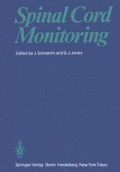Summary
Scalp recordings of responses to spinally-delivered electrical stimuli were performed before and after epidural bupivacaine injection in nine patients. A marked decrease of evoked potential amplitude values to 30% of their initial level was observed within 35 min after epidural blockade. A wide reaching diffusion with involvement of spinal pathways is demonstrated by means of the described neurophysiological method, which may also be valuable in other investigations looking for a pharmacogenic change of spinal cord function.
Access this chapter
Tax calculation will be finalised at checkout
Purchases are for personal use only
Preview
Unable to display preview. Download preview PDF.
References
Bromage PR (1978) Epidural analgesia. Mechanism of action. Saunders, Philadelphia Eastburne Toronto, Chap 4, pp 119–159
Cohen EN (1968) Distribution of local anesthetic agents in the neuraxis of the dog. Anesthesiology 29:1002
Corning JL (1885) Spinal anaesthesia and local medication of the cord. NY Med J 42:483
Kepplinger B (1983) Evoked potentials by means of temporary and permanent implanted spinal cord stimulating systems—preliminary report. Bull Soc Sci Med Grande Duche Luxemb 120: 59–64
Kepplinger B, Wallner K (1985) Technique of evoked potential recordings from a radiofrequency transmitted spinal cord stimulating system. In: Schramm J, Jones SJ (eds) Spinal cord monitoring.Springer, Berlin Heidelberg New York Tokyo, pp 64–66
Kepplinger B, Schmid H, Wallner K (1983) Samples of cortical responses in patients with a permanent cord stimulating system. Electroencephalogr Clin Neurophysiol 54:99
Shealy CN, Mortimer JT, Reswick JB (1967) Electrical inhibition of pain by stimulation of the dorsal columns. Anesth Analg 46:489–491
Wall PD (1967) The laminar organization of the dorsal horn and effects of descending impulses. J Physiol 188:402
Wilkinson GR, Lund PC (1970)Bupivacaine in plasma and cerebrospinal fluid following peridural administration. Anesthesiology 33:482–486
Author information
Authors and Affiliations
Editor information
Editors and Affiliations
Rights and permissions
Copyright information
© 1985 Springer-Verlag Berlin Heidelberg
About this paper
Cite this paper
Kepplinger, B., Schmid, H., Schröttner, O., Leuteritz, R. (1985). Pharmacogenic Changes of Cortical Responses to Spinal Cord Stimulation. In: Schramm, J., Jones, S.J. (eds) Spinal Cord Monitoring. Springer, Berlin, Heidelberg. https://doi.org/10.1007/978-3-642-70687-5_12
Download citation
DOI: https://doi.org/10.1007/978-3-642-70687-5_12
Publisher Name: Springer, Berlin, Heidelberg
Print ISBN: 978-3-642-70689-9
Online ISBN: 978-3-642-70687-5
eBook Packages: Springer Book Archive

